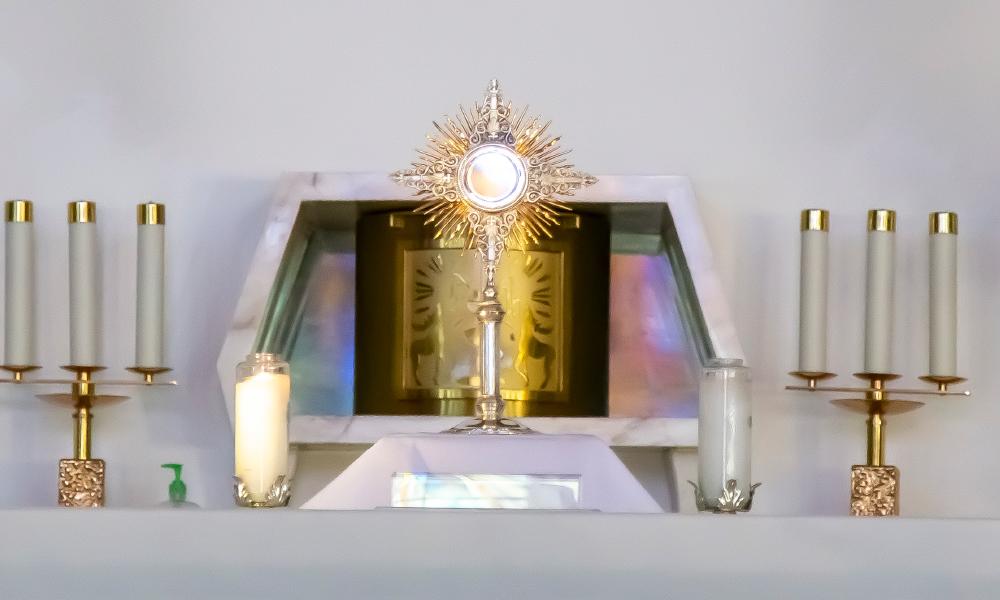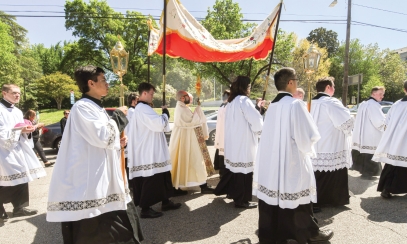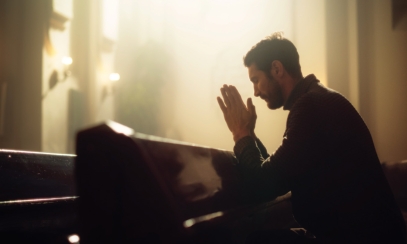
Recognizing Jesus in the Eucharist
In 2019, the Pew Research Center found that two-thirds of adult Catholics believe the bread and wine used at Mass do not become Jesus, but are “symbols of the body and blood.” In each edition this year, we will focus on different aspects of the Eucharist, on the why and how physical objects become, truly, the mystical body and blood of Jesus Christ our Lord.
In reading the daily Gospels during the Octave of Easter, I’ve always found it mind-boggling how the disciples of Jesus struggled to recognize him after his resurrection from the dead. Does the cause of this fogginess reside primarily in the physical/spiritual vision of the beholder — is it their fault — or is it due to differences in Jesus’ glorified and resurrected body that Aquinas says possessed four distinct qualities: clarity, agility, subtlety and impassibility?
In the Gospel of John, the cause seems to reside foremostly in the beholders. Mary Magdalene came to the tomb on Easter morning “while it was still dark” (Jn 20:1) and is described as weeping and emotional, searching frantically for Jesus (Jn 20:11-13; Song 3:1-5). When she finally saw him in the garden near his tomb, she “did not know it was Jesus” (Jn 20:14) until he called her by name. Days later, on the morning after their overnight fishing excursion, Peter and some of the other Apostles fail to immediately recognize Jesus on the shore, 100 yards from their boat on the Sea of Tiberius. Jesus questions them about the results of their empty-handed night and instructs them on where to cast their net before John, the beloved disciple, processing the extraordinary catch of 153 large fish, exclaims, “It is the Lord!” (Jn 21:7)
In the Gospel of Luke, the difficulty is emphatically more pronounced and complicated. Two argumentative and downcast disciples unknowingly encounter Jesus on the road to Emmaus, “but their eyes were prevented from recognizing him” (Lk 20:16). Only after Jesus breaks the Word of God and bread apart do their hearts burn, and they briefly recognize him before he — poof! — vanished from their sight. Upon returning to Jerusalem to tell the other disciples, Jesus stands in their midst and they think they are seeing a ghost. Jesus tells them to touch him and see, and then eats a piece of baked fish to help them understand that his glorified body is real.
In the Gospel of Matthew, the women who are greeted by Jesus on the morning of the resurrection approach him, embrace his feet and do him homage (28:9) as Peter, James and John did at his Transfiguration (17:6). However, after the 11 Apostles saw and worshipped him before his Ascension, they shockingly doubted (Mt 28:17). The key issue seems to be their lack of faith as there seems to be no physical obstruction of their vision on the mountain in Galilee where Jesus had ordered them to gather (Mt 28:16).
Hands down, the most puzzling comment comes from St. Mark in his Gospel, when he states that Jesus “appeared in another form to two of them walking along on their way to the country [Emmaus]” (16:12). The Greek root for “form” here is morphe and seems to indicate that he exercises in some manner the shape-shifting power of the mutant Mystique from the X-Men comic books. Along this line, Aquinas seriously asks in his Summa Theologiae, “Whether Christ should have appeared to the disciples in another shape” (III, Q.55, A.4). In essence, it seems Jesus not only became the Word and said what each of his disciples needed to truly hear, but appeared as each demanded as well.
I recall all of these post-resurrection episodes regarding the difficulties of the disciples in recognizing Jesus as Jesus because uproar has reverberated since a 2019 Pew Research study found that only 30% of baptized Catholics believe the Eucharist is more than just a symbol, that is to say, it is the body and blood of Jesus Christ. Or, to phrase this disheartening find in the language of St. Mark, only 30% of baptized Catholics believe that Jesus continues to truly, really and substantially appear in another form to each of us — under the appearance of bread and wine.
What are we to make of this? Should we merely blame a lack of catechesis or shifting cultural currents that are void of depth perception and a sacramental vision of the world? I think we who profess and believe that the Eucharist is Jesus should thank God for the great gift of that faith, but should also embrace the fatherly rebuke Jesus gave to his first disciples who struggled to believe in what they saw (Mk 16:14) — in the various forms he has and continues to appear.
In reflecting upon Mark 16:12 (“he appeared in another form”), the Swiss Catholic convert, physician, wife and mystic Adrienne Von Speyr writes, “In the Old Covenant, [Jesus] was from the beginning the promised Word … Then he became the Father’s seed, when Mary was overshadowed by the Holy Spirit. Then man. But already his earthly, human form was not a single one but developed as it does in every person. He grew and changed … But now, after the resurrection, his freedom has become infinitely greater: he can determine his form as he wishes … Can the Lord also appear to us in an unfamiliar form? Surely first through his commandment of love of neighbor, in which he tells us, ‘What you did to the least of my brethren, you did it to me.’ But he is also the Way, the Door. He is everything that leads to the Father … And we must always strive to recognize him in every form, even in his form of bread.”
The feast of Corpus Christi will be celebrated on June 6 this year and will provide each of us with an opportunity to slow down and think more deeply about Jesus’ ability to substantially appear in many forms. The question is whether or not we will recognize him and believe in the form he appears.
Father David D. Nerbun has a doctorate in sacred theology from the Pontifical John Paul II Institute for Studies on Marriage and Family. He is the diocesan vicar for Family Life, chaplain to Coastal Carolina University and is forming the new Catholic community in Carolina Forest.



